Cedar Waxwing
(Bombycilla cedrorum)
Conservation • Description • Habitat • Ecology • Distribution • Taxonomy
|
|
||||||||||||||
Description |
Cedar Waxwing is a sleek, medium-sized bird. It is 6″ to 7¼″ long, weighs about 1.1 ounce., and has a wingspan of about 12″. It is a year-round resident of Minnesota. The body is grayish-brown with a yellowish wash on the breast and belly. The wings are pointed, grayish-brown, and have a white inner edge. There are waxy, bright red "drops" at the tips of the secondary wing feathers. The wing tips—the tips of the primary feathers—are dark and do not have any bold markings. The tail is gray, square, somewhat short, and tipped with a bright yellow band. The undertail coverts are white. The neck is short, the head is large, and the bill is short and wide. The head and neck are cinnamon brown. The chin is black and there is a narrow black mask outlined in white. There is a crest that droops over the back of the head. Males and females are mostly alike, but the male has a darker chin. |
Size |
6″ to 7¼″ in length 12″ wingspan |
Voice |
|
|
A clear, high-pitched whistle, not ascending or descending in pitch, repeated one to four times; a high-pithed trilled whistle, repeated one to four times. |
Similar Species |
Bohemian Waxwing (Bombycilla garrulus) is slightly larger, up to 8″ long. The undertail coverts are chestnut, not white. The body is brownish-gray without a yellow wash. The inner edge of the wing is not white. The secondary wing feathers have white tips, which appears as a white patch above the red "drops". The wing tips have bold yellow and white markings. They are found in Minnesota only in the winter. |
Habitat |
Forest edges, open woodlands, riparian forests, urban parksForest edges, open woodlands, riparian forests, urban parks |
Ecology |
Migration |
|
Nesting |
The Breeding season is June through August, usually one brood in the spring and a second brood in the summer. The female builds the first nest in about five days by weaving together twigs, grasses, moss, and lichens, then lining the interior with soft grasses. The finished nest is cup shaped, about 5″ in diameter, and about 3″ high. The female lays 2 to 6 (usually 4 or 5) eggs which hatch after 11 to 13 days. The hatchlings stay in the nest 14 to 18 days. |
Food |
Mostly fruits; in the summer also eats flying insects. |
Distribution |
Occurrence |
Common to abundant migrant and breeder |
Maps |
The Minnesota Ornithologists’ Union All Seasons Species Occurrence Map |
Taxonomy |
|
Class |
Aves (birds) |
Order |
Passeriformes (perching birds) |
Family |
Bombycillidae (waxwings) |
Genus |
Bombycilla (waxwings) |
Subordinate Taxa |
|
|
|
Synonyms |
|
|
|
Glossary
Coverts
Small feathers on the wings and tail of a bird that cover other feathers and help smooth airflow during flight.
Visitor Photos |
||
Share your photo of this bird. |
||
This button not working for you? |
||
Gregory Gilman |
 |
The Cedar Waxwing They're back this year but cannot come close to this spectacular previous shot. |
Ramona Abrego |
||
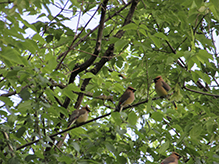 |
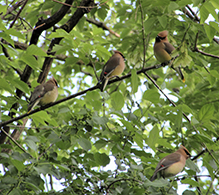 |
|
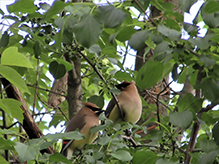 |
 |
|
Norm & Peg Dibble |
||
Pretty Cedar Waxwings are regular visitors to the pond. There are typically 4 of them at a time. This was taken from the house probably through the glass patio door. They are the fastest bathers of all the birds it seems and it’s a real challenge to get a focused picture. If I’m outside, I usually hear them before I see them. They are quite vocal but only soft squeaky chirps. |
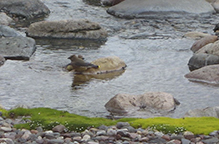 |
|
Laurie Wachholz |
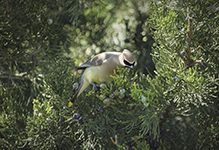 |
Joy Blank |
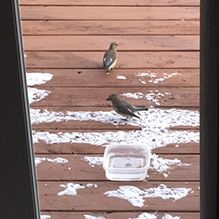 |
Bill Reynolds |
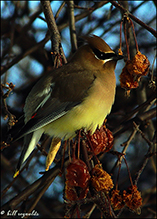 |
Here is a Cedar Waxwing feeding on Splendid Crab apples. |
Tom Baker |
||
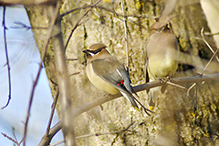 |
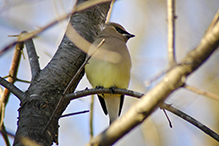 |
|
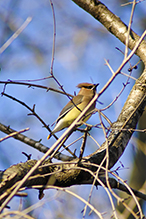 |
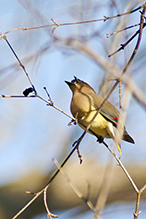 |
|
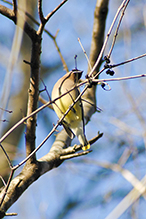 |
||
MinnesotaSeasons.com Photos |
||
|
||
|

Slideshows |
Cedar Waxwing |
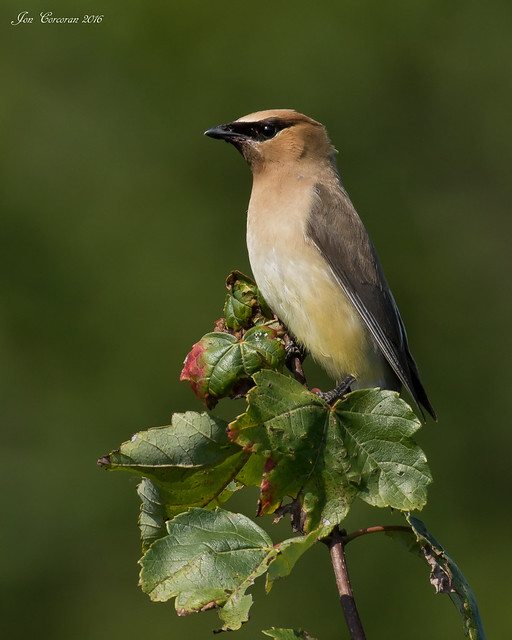
|
Cedar Waxwing |
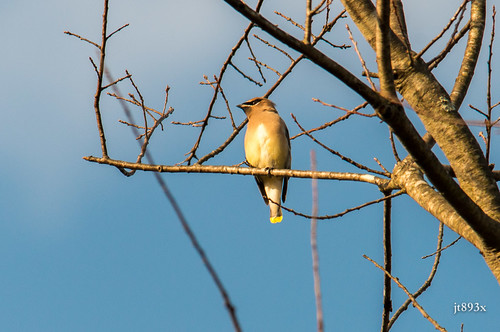
|
Cedar Waxwing |

|
About
Bombycilla cedrorum |
Cedar Waxwing |
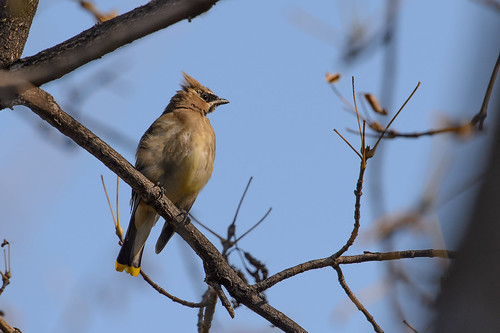
|

Visitor Videos |
||
Share your video of this bird. |
||
This button not working for you? |
||
|
Other Videos |
||
Visitantes silvestres: Bombycilla cedrorum |
About
Uploaded on Feb 6, 2007 Corto sobre las aves migratorias Bombycilla cedrorum conocidas como chinitos o ampelis americanos, que vienen a México desde Canadá y EUA. |
Maplewood Flats Cedar Waxwings |
About
Uploaded on Jan 26, 2011 Cedar Waxwings have been observed to pass blossoms, berries and other food items to potential mates as a courtship ritual. (Bombycilla cedrorum ) |
Cedar Waxwing (Bombycillidae: Bombycilla cedrorum) |
About
Uploaded on Jul 6, 2009 Photographed at East Grand Forks, Minnesota (06 July 2009) |
Cedar Waxwing-Bombycilla cedrorum |
About
Published on May 25, 2013 Cedar Waxwing ( Bombycilla cedrorum ) eating petals. Video taken on 5-25-2013 Montrose Point Bird Sanctuary "The Magic Hedge" |

Visitor Sightings |
||
Report a sighting of this bird. |
||
This button not working for you? |
||
Gregory Gilman |
Location: NW Rochester, MN They're back this year but cannot come close to this spectacular previous shot. |
|
| Holly Henslin Link 3/6/2022 |
Location: Eden Prairie, MN I saw a flock of about 20 Cedar Waxwings in a crab apple tree on the west side of Mitchell lake, Eden Prairie today. They were having a wonderful feast, and were very docile, curious and chirpy. |
|
| Ramona Abrego | Location: Washington County |
 |
Delfun-Peterson |
Location: Marine on Saint Croix lived here 30 years, first sighting. |
|
| Joy Blank 12/9/2017 |
Location: St. Cloud, MN |
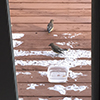 |
| Cris Risberg 9/5/2017 |
saw them eating insects from a boxelder tree in my back yard. At least 6 -10 of them |
|
| R Klossner 6/16/2017 |
Location: Cottage Grove Drank from 3 different fountains in backyard. |
| Tom Baker 2/18/2012 |
Location: Edenbrook Conservation Area |
 |
Gregory Gilman |
Location: NW Rochester, MN
|
 |
| Bill Reynolds 2/5/2007 |
Location: Pennington Co. Here is a Cedar Waxwing feeding on Splendid Crab apples. |
 |
MinnesotaSeasons.com Sightings |
||

Created: 7/24/2012 Last Updated: © MinnesotaSeasons.com. All rights reserved. |
